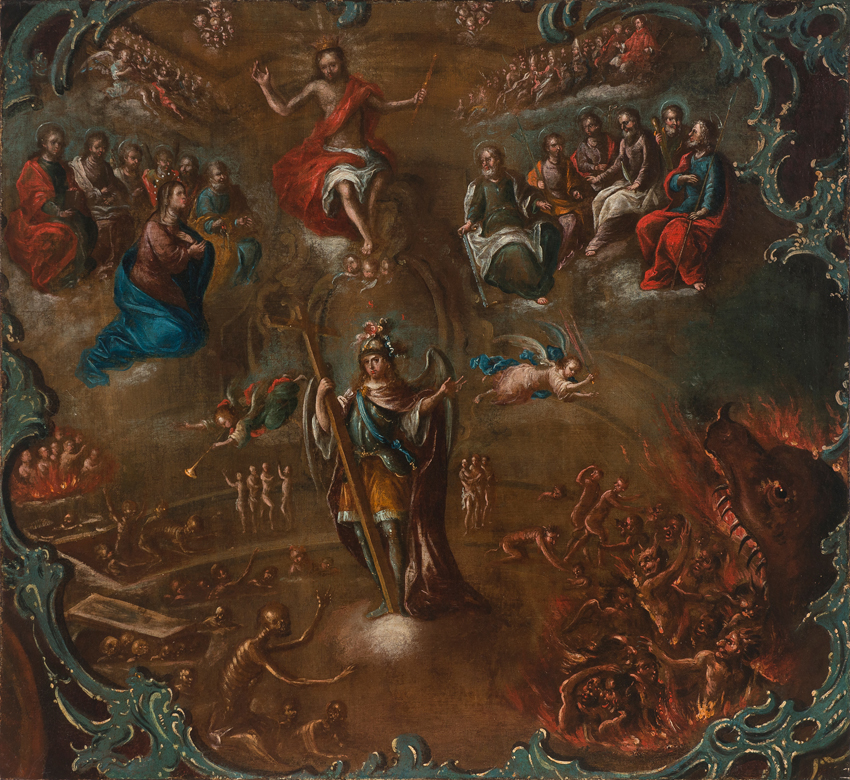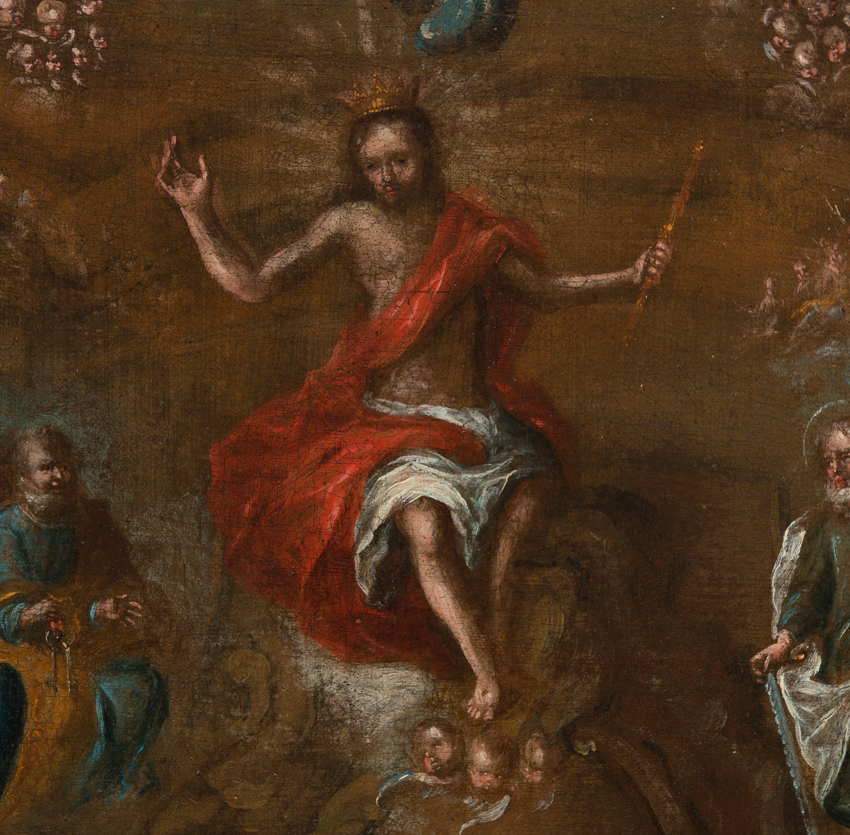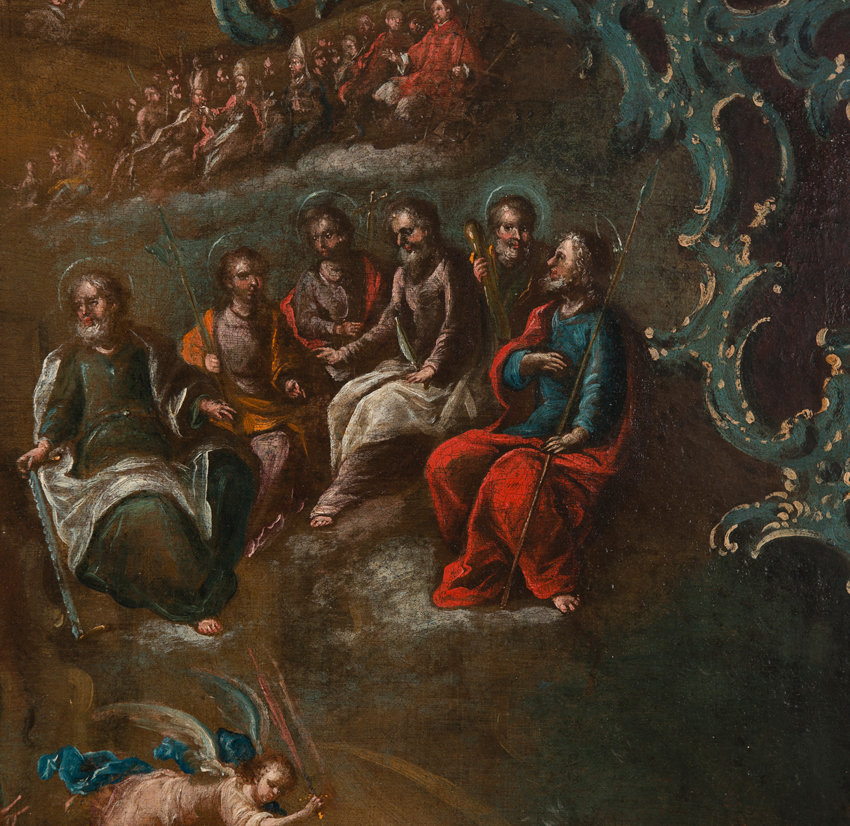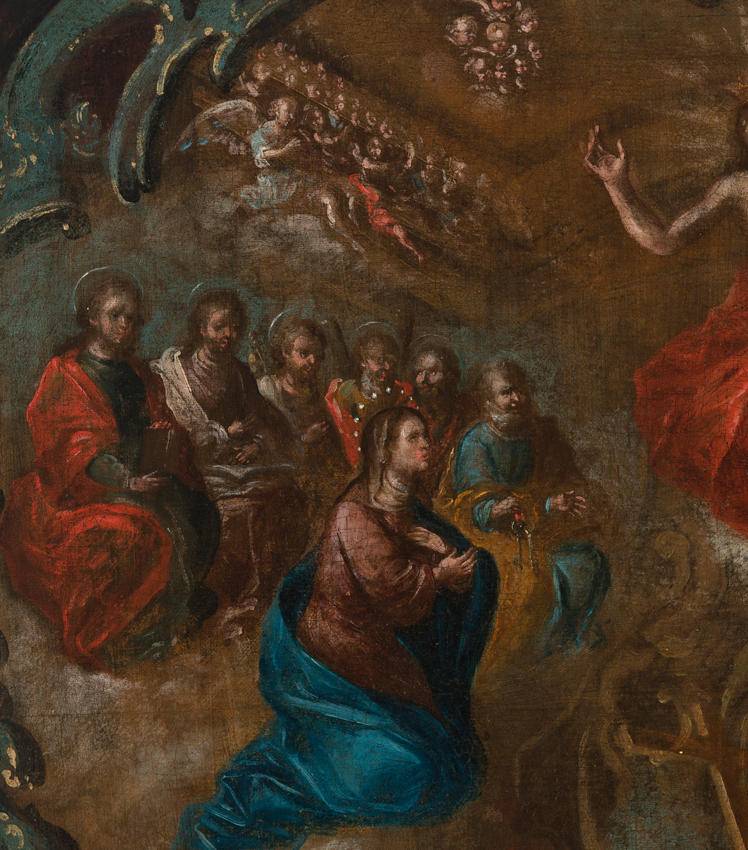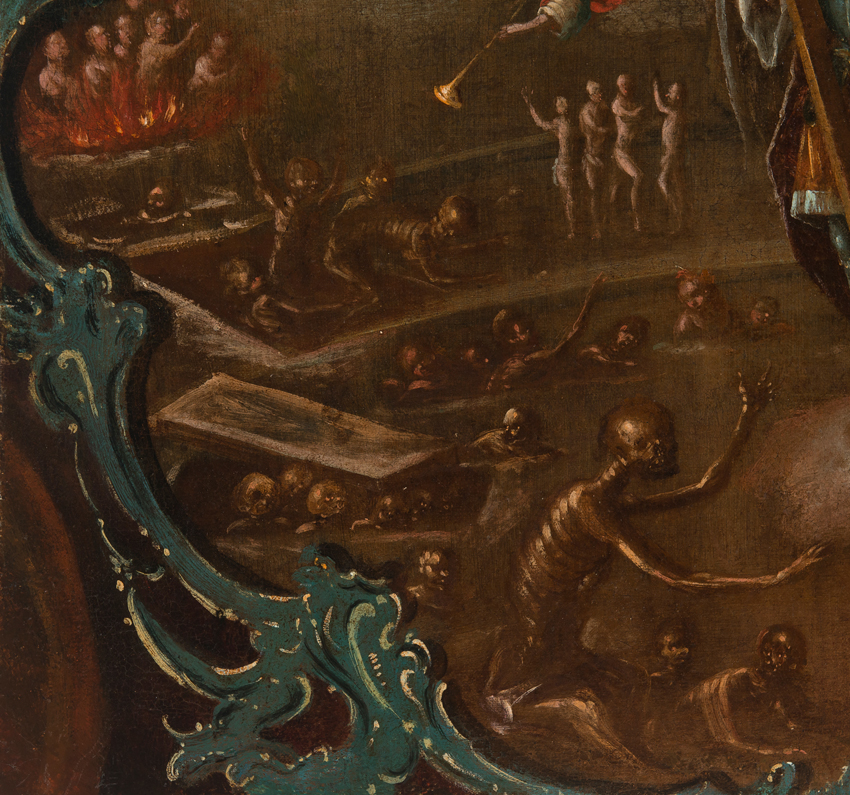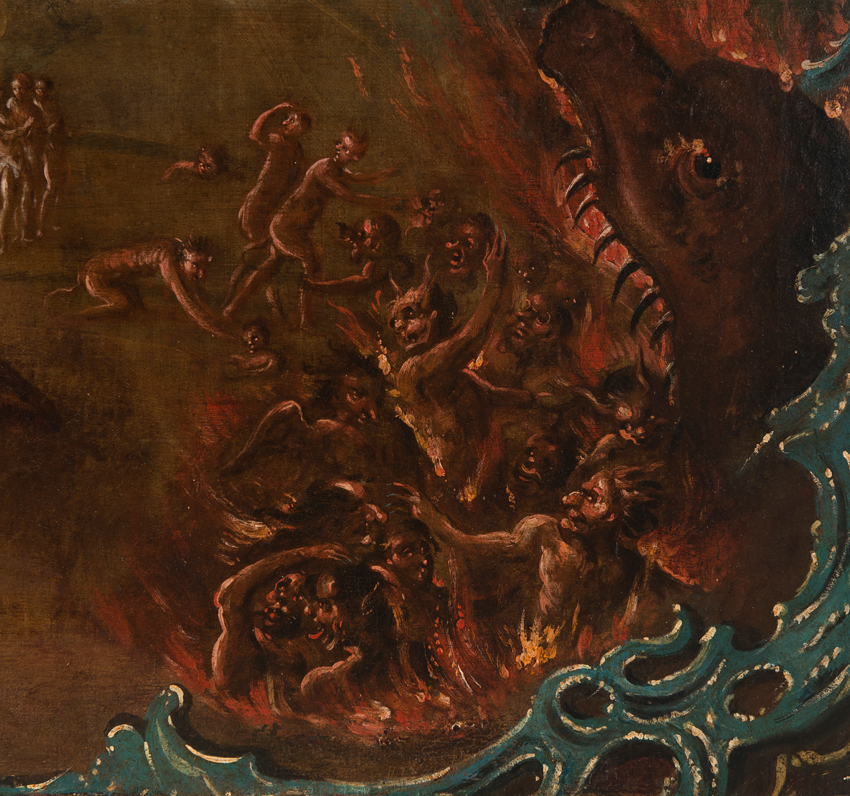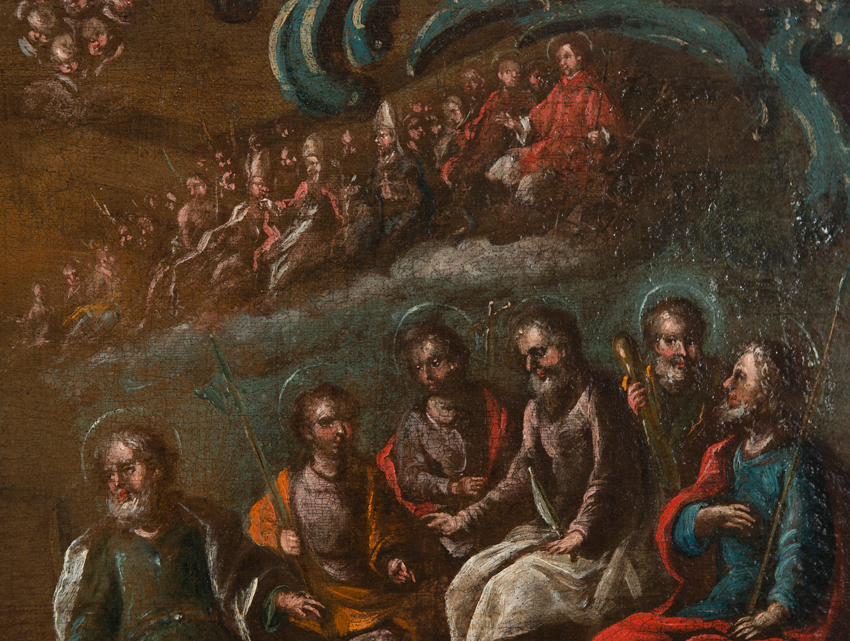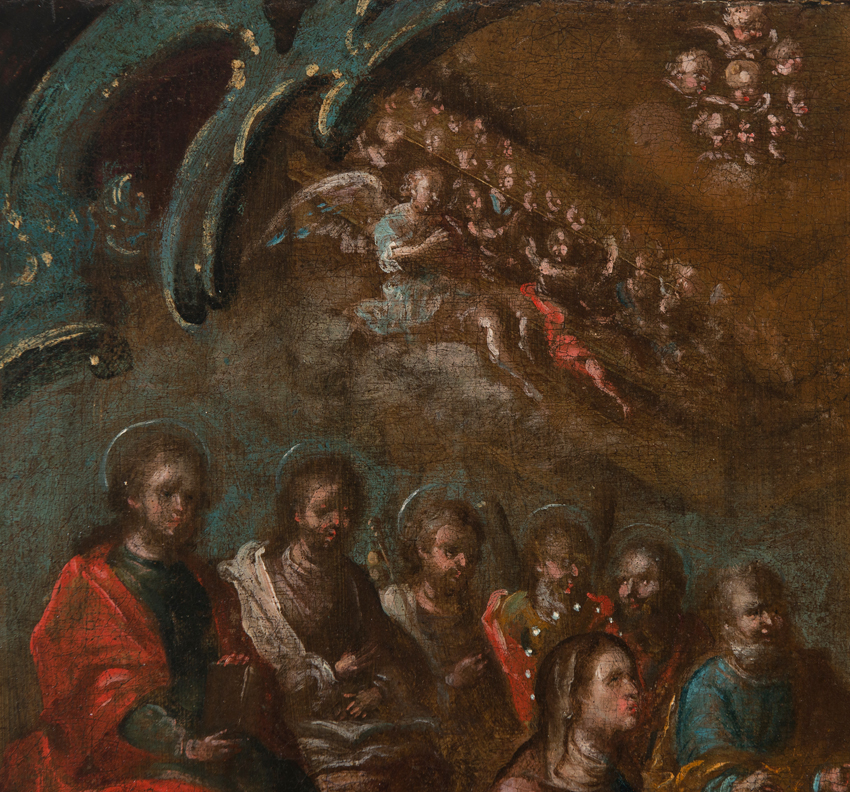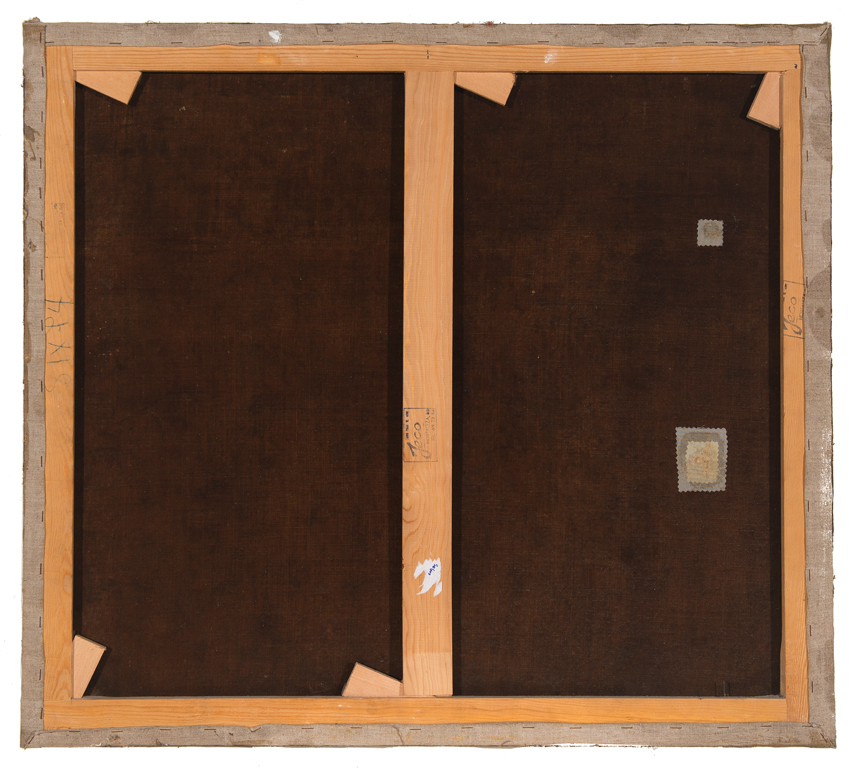154
Viceregal School. Cuzco Perú. Siglo XVIII. Attributed to Antonio Vilca (Cuzco, Viceroyalty of Peru,
Viceregal School. Cuzco Perú. Siglo XVIII. Attributed to Antonio Vilca (Cuzco, Viceroyalty of Peru, active from 1778–1803)
“Heaven and Hell. The second coming of Christ and the Last Judgment”
Oil on canvas. Relined.
74 x 81 cm.
Apocalyptic work that portrays the Last Judgment, portraying the second coming of Christ and the Last Judgment of the world with maximum detail and finesse. In the center of the painting the one who imparts justice, St. Michael, stands out. He is the one who does the sifting, the chief of the angels and archangels, holding a cross, so that we contemplate the cross, from which the Salvation of the world hangs.
Above, centered, the figure of Christ is depicted, crowned as King of the Universe, serene and giving blessing, flanked by the 12 apostles and Mary his mother, kneeling. A king surrounded by his entire entourage, the choir of saints and angels.
The lower half of the painting shows the punishment of the damned, with demons and monsters being tortured in a frightful way and swallowed in the midst of an unending fire. We say, without hesitation, that these were catechetical paintings. These paintings were intended to teach and show the viewer the consequences of sin and the importance of leading a virtuous life. Heaven and hell, salvation and redemption, with the promise of a better future life for those who live a good life. The contrast between heaven and hell is used to highlight the importance of morality and the consequences of one's actions.
Depictions of heaven and hell in Novo-Hispanic art, and in art in general, have been a popular theme for centuries, and artists have explored everything from the sublime to the grotesque, different visions of glory and the underworld, from the most iconic and haunting to the darkest and most twisted.
With this painting we can also get a glimpse into the mind of this artist, who frames the scene in a baroque rockery and in a celestial window of grayish blue, captures for us the world of beliefs, fears and theology that he saw and felt, through which he tried to help us learn and live the faith.
In general, hell in art serves as a reminder of the dark human side and the importance of leading a virtuous life.
It is a theme that has left an indelible mark on our collective imagination and continues to inspire and/or terrify us to this day. Undoubtedly, this theme has been depicted with extreme beauty by this Novo-Hispanic artist, which makes the image much kinder and easier to assimilate, more merciful and redeeming.
Viceregal School. Cuzco Perú. Siglo XVIII. Attributed to Antonio Vilca (Cuzco, Viceroyalty of Peru, active from 1778–1803)
“Heaven and Hell. The second coming of Christ and the Last Judgment”
Oil on canvas. Relined.
74 x 81 cm.
Apocalyptic work that portrays the Last Judgment, portraying the second coming of Christ and the Last Judgment of the world with maximum detail and finesse. In the center of the painting the one who imparts justice, St. Michael, stands out. He is the one who does the sifting, the chief of the angels and archangels, holding a cross, so that we contemplate the cross, from which the Salvation of the world hangs.
Above, centered, the figure of Christ is depicted, crowned as King of the Universe, serene and giving blessing, flanked by the 12 apostles and Mary his mother, kneeling. A king surrounded by his entire entourage, the choir of saints and angels.
The lower half of the painting shows the punishment of the damned, with demons and monsters being tortured in a frightful way and swallowed in the midst of an unending fire. We say, without hesitation, that these were catechetical paintings. These paintings were intended to teach and show the viewer the consequences of sin and the importance of leading a virtuous life. Heaven and hell, salvation and redemption, with the promise of a better future life for those who live a good life. The contrast between heaven and hell is used to highlight the importance of morality and the consequences of one's actions.
Depictions of heaven and hell in Novo-Hispanic art, and in art in general, have been a popular theme for centuries, and artists have explored everything from the sublime to the grotesque, different visions of glory and the underworld, from the most iconic and haunting to the darkest and most twisted.
With this painting we can also get a glimpse into the mind of this artist, who frames the scene in a baroque rockery and in a celestial window of grayish blue, captures for us the world of beliefs, fears and theology that he saw and felt, through which he tried to help us learn and live the faith.
In general, hell in art serves as a reminder of the dark human side and the importance of leading a virtuous life.
It is a theme that has left an indelible mark on our collective imagination and continues to inspire and/or terrify us to this day. Undoubtedly, this theme has been depicted with extreme beauty by this Novo-Hispanic artist, which makes the image much kinder and easier to assimilate, more merciful and redeeming.
Vanitas, Parables and Devotions
Sale Date(s)
Venue Address
General delivery information available from the auctioneer
The purchase price includes the delivery of the lots in the venue of the auction. Transporting to other destinations is at the own risk of the client. The customer must contact "LST", to give the corresponding instructions for such transporting. "LST" is not responsible for the packaging or any accident incurred during transportation.
Important Information
Terms & Conditions
CONDITIONS OF THE AUCTION:
I. REGISTRATION. To bid in the room customers must register at the beginning, filling out a form and picking a number that will identify them during the auction. Customers may be required to register in bank references or other guarantee system and if they do not prove the solvency "LST" will not accept bids and award the auction.
II. WRITTEN BIDS. "LST" will accept written bids, which will be formalized in the form provided by the room until the day before the auction. In such auctions, the room will bid in name of the client until the maximum stated in the offer and always at the lowest possible price. If there are two or more bids for the same amount, the one placed first will have the priority. Written bids received in advance, will have priority on the day of the auction.
III. TELEPHONE BIDS. "LST" will allow telephone bids, if interested people contact "LST" days before the auction providing personal data, ID card and the phone number which will be used by the staff of "LST" to call at the time of the auction. The buyer, within all the legal rights is making an offer for the asking price, when applies for telephone bid. "LST" will not take responsibility for any technical defects beyond its control, which may prevent to contact successfully the bidder during the auction.
IV. AUCTIONEER. The auction will be conducted by an auctioneer, director of the auction will be judge and arbitrator of it with full authority in its development, will award the lots to the highest bidder and is able to settle any controversy concerning lots sale, reject bids, divide lots or group them and remover objects from the room. Will be able to, if it is deemed suitable, not accept bids on the auction. His decision will be unappealable.
V. SALE OF LOTS. The lots are awarded to the highest bidder. Once the auctioneer blows the hammer, the buyer becomes responsible of the lot purchased, exempting "LST" of liability to for any damage and / or accidents that may occur. No refunds of lots.
VI. STARTING PRICE. The amount shown in the catalogue as the starting price for each lot will be, as a rule, the minimum selling price, except for exceptional cases where a reservation may be agreed upon with the seller or it set discretionary by the room.
VII. SCALE OF BIDS. The bids are set according to the following scale:
From 50.-€ to 200.-€…………………………………………..at 10.-€
From 200.-€ to 500.-€…………………………………… …25 in 25.-€
From 500.-€ to 1.000.-€………………………………..…..….50 in 50.-€
From 1.000.-€ to 2.000.-€………………………………..…100 in 100.-€
From 2.000.-€ to 5.000.-€……………………………….….250 in 250.-€
From 5.000.-€ to 10.000.-€…………………………………500 in 500.-€
From 10.000.-€ to 20.000.-€……………………………1.000 in 1.000.-€
From 20.000.-€ to 50.000.-€……………………………2.500 in 2.500.-€
From 50.000.-€ to 100.000.-€…………………………..5.000 in 5.000.-€
From 100.000.-€ to 100.000.-€………………………10.000 in 10.000.-€
From 200.000.-€ to 200.000.-€………………………25.000 in 25.000.-€
From 500.000.-€ to 500.000.-€………………………50.000 in 50.000.-€
VIII. RIGHT OF ADMISION. "LST" reserves the right to admission to the auction room and to reject, at its judgment, any purchase order, from clients whose solvency is not duly proved as well as not to sale auctions.
IX. SALE PRICES. The successful bidder of one or more lots must pay "LST" the final sale price achieves at auction, plus the 24,5 % plus 21% VAT on the commission, at total 29,64 % on Hammer Price.
X. CATALOG DATA. The catalogue data are obtained in order to careful research and advice, however, any responsibility is afforded about its accuracy. The lots will be auctioned in the state in which they are, not accepting any claims in restorations, breakage, damage, imperfections and, even description or numbering mistakes in the catalogue, in case of it, being the burden of the buyers to make sure before the auction that the description matches with their personal opinion about respective lot. The exhibition of the lots is intended to allow a perfect review and study of them.
XI. PAYMENT AND REMOVAL OF LOTS. Payment and removal of the lots will be held no later than five days following the auction. After this period expire without having the buyer removed the lot or lots purchases, it will accrue an expense of custody of 6 euros per day on each lot.
15 days after the auction without having the buyer paid and removes the sold lots, "LST" will inform the seller and there will begin judicial proceeding in order to obtain payment. The delay in payment by the purchaser of his/her sold lots will carry an interest increase at a rate of 1,5% per month.
XII. DELIVERY OF LOTS. The purchase price includes the delivery of the lots in the venue of the auction. Transporting to other destinations is at the own risk of the client. The customer must contact "LST", to give the corresponding instructions for such transporting. "LST" is not responsible for the packaging or any accident incurred during transportation.
XIII. RIGHT OF FIRT REFUSAL AND REPURCHASE. "LST" in order to article 38 of "Ley 16/1985 de 25 Junio del Patrimonio Histórico Español" (BOE. 155 June 29, 1985), will notify in advance to the Ministry of Culture, the content of their catalogues. Concerning the lots subject to the legislation referred to in the preceding paragraph, the Administration may exercise the rights of first refusal and repurchase according to the law. "LST" will watch over the protection of Artistic, Historical and Bibliographical Heritage of Spain. For customers out of European Community, a tax for export is required by the Administration.
XIV. VALUE ADDED TAX (I.V.A). This tax will be accrued on commissions of "LST" for buyers, using the rates prevailing on the date of the auction.
XV. DATA PROTECTION. In order to the "Ley 15/1999 de 13 de Diciembre, de Protección de Datos de Carácter Personal", the client authorize "LST", the inclusion of their data in a customer file, and for the promotion by "LST" of the objects at all times the rights of access, rectification or deletion of personal data by sending the appropriate request to the following address: LA SUITE SUBASTAS, C/ Conde Salvatierra, 8, 08006. Barcelona.
XVI. EXPRESS LEGAL JURISDICTION. These Conditions are governed by and interpreted in accordance with the rules of Spanish law. The mere act of participating in the auction as seller, buyer or bidder, implies acceptance of these Terms and Conditions.
Sales operations are understood to be held at the registered office of "LST", C/ Conde de Salvatierra, 8, 08006. Any dispute shall be taken to the competent courts of Barcelona, expressly waiving any other jurisdiction, in accordance with Article 55 of the "Ley de Enjuiciamiento Civil".
























